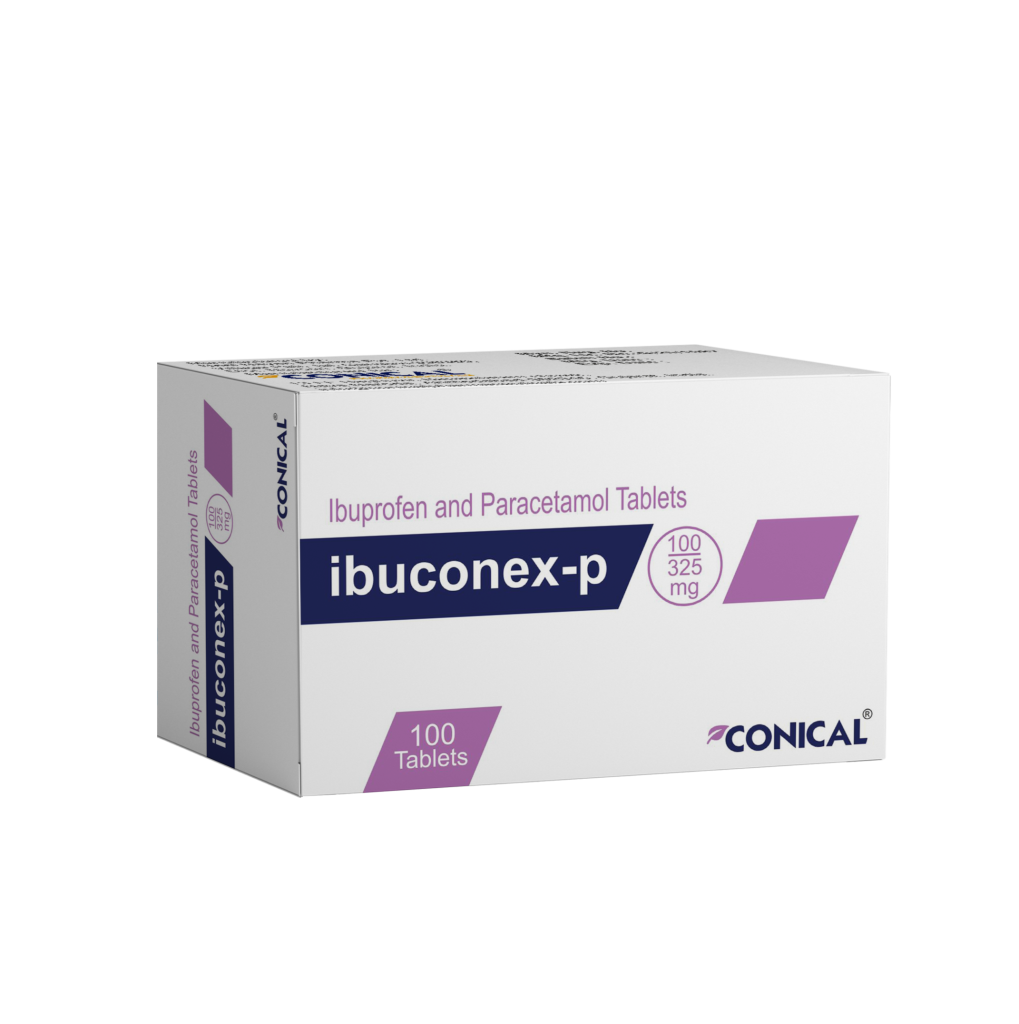







Ibuprofen and Paracetamol Tablets 100/325 mg use For temporary relief of pain associated with: headache, migraine, backache, period pain, dental pain, muscular pain, cold and flu symptoms, sore throat and fever.
The use of paracetamol at higher than recommended doses can lead to hepatotoxicity and even hepatic failure and death.
Patients who regularly consume alcohol in excess of recommended amounts should not take this medicine.
Paracetamol can be used in patients with chronic renal disease without dosage adjustment. There is minimal risk of paracetamol toxicity in patients with moderate to severe renal failure. However, for the ibuprofen component of this product – caution should be used when initiating treatment with ibuprofen in patients with dehydration.
Blood dyscrasias have been rarely reported. Patients on long-term therapy with ibuprofen should have regular haematological monitoring.
Like other NSAIDs, ibuprofen can inhibit platelet aggregation. Products containing ibuprofen should be used with caution in persons with intrinsic coagulation defects and those on anti-coagulation therapy.
Upper gastro-intestinal ulcers, gross bleeding or perforation have been described with NSAIDs. Products containing ibuprofen should be used with caution, and at the lowest effective dose for the shortest duration, in patients with a history of gastrointestinal haemorrhage or ulcer since their condition may be exacerbated.
Patients with uncontrolled hypertension, congestive heart failure (NYHA II-III), established ischaemic heart disease, peripheral arterial disease, and/or cerebrovascular disease should only be treated with ibuprofen after careful consideration and high doses (2400 mg/day) should be avoided.
Products containing ibuprofen should not be administered to patients with acetylsalicylic acid sensitive asthma and should be used with caution in patients with pre-existing asthma.
As with other drugs of this class containing ibuprofen, by reducing fever this may mask the usual signs of infection.
Patients should be advised of the signs and symptoms of serious skin reactions and to consult their doctor at the first appearance of a skin rash or any other sign of hypersensitivity.
For oral administration and short term use only.
Undesirable effects may be minimized by using the lowest effective dose for the shortest duration necessary to control symptoms.
The patient should consult a doctor if the symptoms persist or worsen or if the product is required for more than 3 days.
Adults:
The usual dosage is one to two tablets taken every six hours, as required, up to a maximum of six tablets in 24 hours.
Children under18 years:
This product is not recommended for children under 18 years.
Elderly:
No special dosage modifications are required (see section 4.4). The elderly are at increased risk of the serious consequences of adverse reactions. If an NSAID is considered necessary, the lowest effective dose should be used for the shortest possible duration. The patient should be monitored regularly for gastrointestinal bleeding during NSAID therapy.
Oedema, fluid retention; fluid retention generally responds promptly to discontinuation of the drug, Tinnitus (for medicines containing ibuprofen), Abdominal pain, diarrhea, dyspepsia, nausea, stomach discomfort and vomiting, Dizziness, headache, nervousness, Rash (including maculopapular type), pruritus.
Store below 30°C temperature and protect from light.
Keep the medicine out of reach of children.
10 x 10 Alu/PVC blister pack
Ibuconex-P is available in an Alu/PVC blister of 10 tablets. Such 10 blisters in a unit carton with package insert.
Contact us directly to receive full information on the product, the formulation, the science behind it, stability data, and more. Our Business Development Manager is a click away.
Questions are useful tools, they open lines of communication; give us information; improve interactions, facilitate analysis, and many more.
A pharma CMO is a special kind of an organization, offering contract manufacturing services to pharmaceutical companies for various kinds of drug formulations.
Reduce overall costs and time to market :
Contract manufacturers already have the needed infrastructure and technical staff, so working with a CMO or CDMO can decrease the cost of manufacturing your pharmaceutical products.
Scalability and flexible production capacity :
You can produce what you need when you need it without worrying about excess capacity. Additionally, CMOs understand the importance of quality and compliance, so you don't have to sacrifice safety for scalability.
Save on upgrading and maintaining equipment :
If you have your manufacturing facility, you’ll have to pay to upgrade your equipment as technology advances—which can get expensive. A CMO/CDMO’s only function is to make and distribute products, so part of their core business responsibility is to update their equipment whenever needed and perform maintenance.
Ease supply chain issues :
During the pandemic, there were several instances of supply chain issues, including medicine shortages. CMOs are generally better equipped than startups to handle a supply chain crisis.
Bandwidth to focus on core competencies
When your company resources aren’t directly allocated to manufacturing and distribution, you have more time to focus on other tasks, like marketing your new drug, researching, or working on drug discovery.
We have 7+ manufacturing sites with a minimum of WHO GMP certification and other country-specific approvals like NAFDAC approved, PPK Kenya Approved, TFDA Tanzania Approved, EU-GMP Approved.
We have below manufacturing capacity:
For Tablet, Capsule, and soft gel: up to 1 million units per shift
For Syrup: up to 0.05 Million per shift
For Ampoule and Vial: up to 0.1 million units per shift
For Ointment and Cream: up to 0.1 million units per shift
For Suppository: 0.1 Million units per shift
